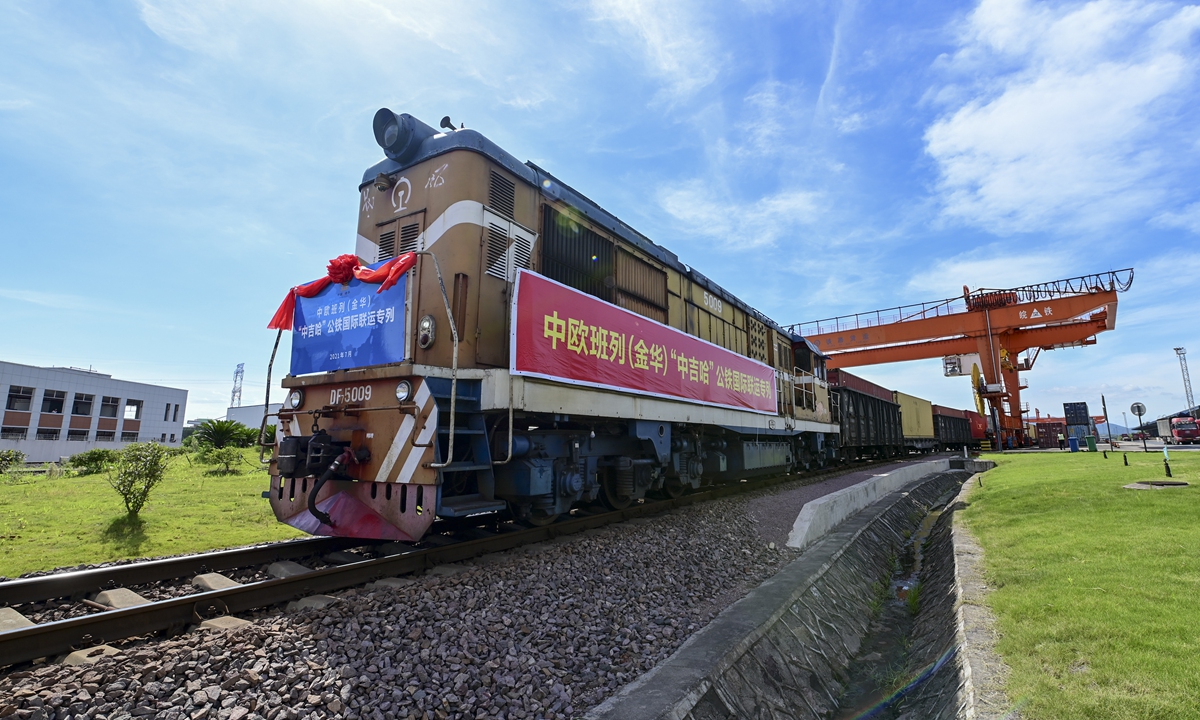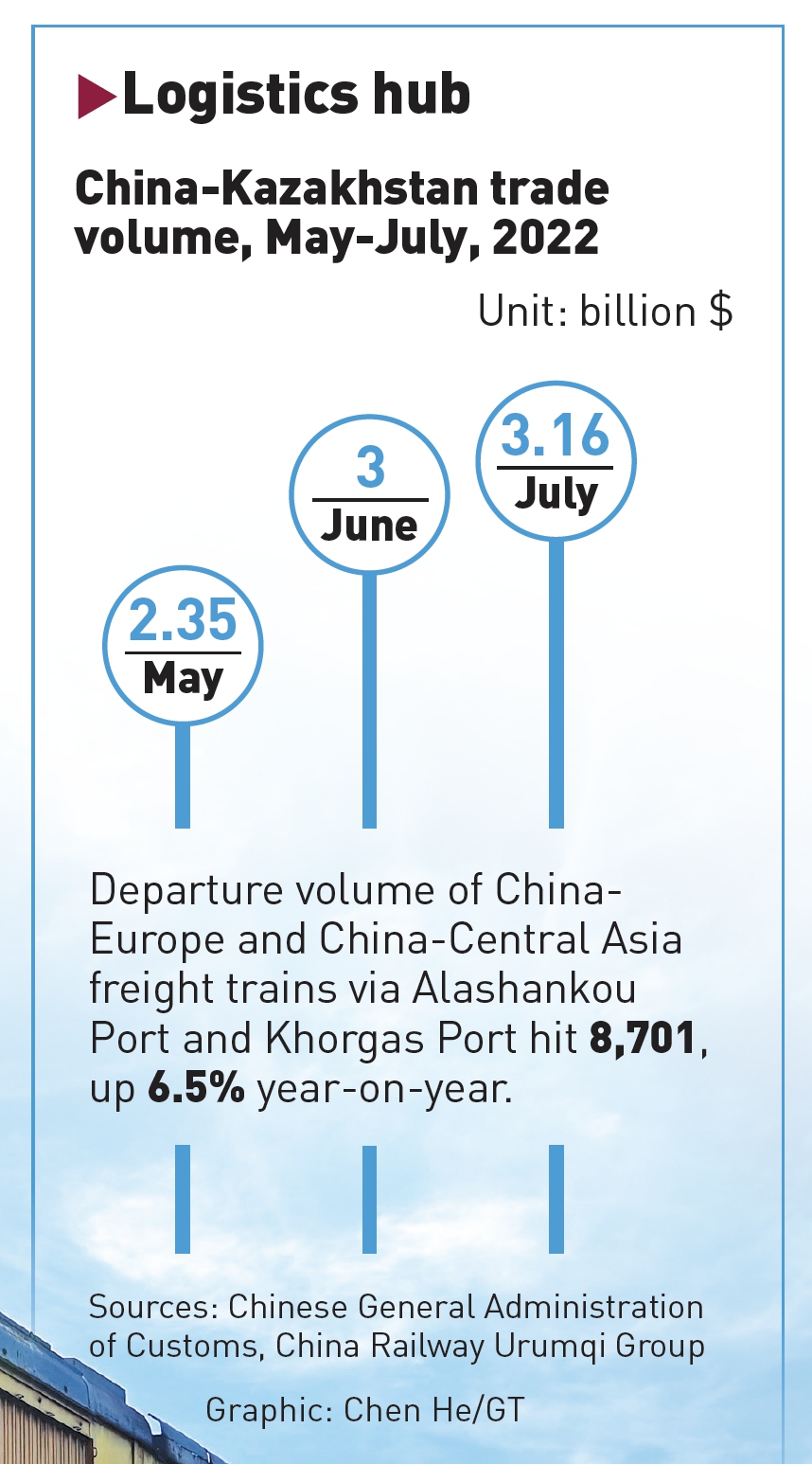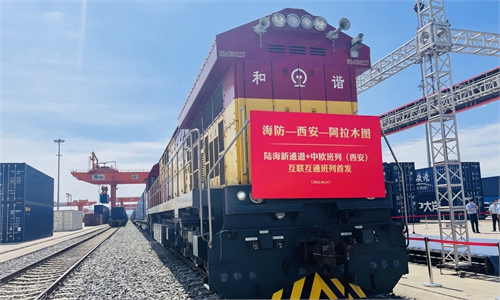China-Europe freight trains inject momentum into regional trade growth between Kazakhstan and beyond
China-Europe freight trains bolster greater connectivity across Central Asia under a shared future

The China-Kyrgyzstan-Kazakhstan freight train departs Jinhua in East China's Zhejiang Province. Photo: VCG
A train loaded with tons of Chinese goods departs the port in Central China's Luoyang, Henan Province on Monday before heading to its scheduled destination - Uzbekistan, marking the 30th cross-border cargo train from the city to Central Asia, as the latest mirror of how the trade activities between China and the regional countries have remained resilient, despite the epidemic, inflation, geopolitical conflicts and other challenges.
From January to August, there were totally 8,701 cross-border freight trains passing across the Alashankou and Khorgas ports, the two major border ports in Northwest China's Xinjiang Uygur Autonomous Region, a year-on-year increase of 6.5 percent, according to a statement shared by the Urumqi railway bureau with the Global Times on Tuesday, reflecting a positive contribution of the high-quality joint construction of the transportation lines under the Belt and Road Initiatives (BRI).
Among the Central Asian countries, Kazakhstan plays a foundational role in the trade between China and the Eurasian region, while serving as an important channel for China to link Eurasian countries as the northern line of the China railway express.
From January to July, China-Kazakhstan trade volume reached $17.67 billion, a year-on-year increase of 18.9 percent, which is expected to hit a record high throughout the year, media reported. China has become not only an increasingly important market for the country but an ideal transportation hub for Kazakhstan goods to reach other countries via sea.
Bucking the trend
When the world is in the midst of rampant inflation, sporadic outbreaks of COVID-19 continue at home and abroad, and geopolitical conflicts linger, trade activities between China and the Central Asian countries have remained both stable and upward looking, as official trade data showed.
While there are multiple factors which have contributed to the stable flow of trade across the region, industry insiders contacted by the Global Times on Tuesday said that the key lies in the high-efficiency of the rail service and the high complementarity between China and the regional countries, with Kazakhstan the pillar of the trade growth.
In the face of the epidemic outbreaks in some parts of Xinjiang, Wu Qi, a person with China Railway Urumqi Group told the Global Times on Tuesday that they have ramped up efforts to utilize train service with measures such as 24/7 working shifts to ensure that cargos can be loaded or unloaded at the earliest opportunities upon arrival.
As the result of the efficiency measures, from January to August, there were 8,701 cross-border cargo trains travelling across the Alashankou and Khorgas ports in Xinjiang, representing year-on-year growth of 6.5 percent.
Trade activities between China and Central Asian countries have maintained a positive trend, given the increasingly high complementarities between China and the regional countries, a Kazakhstani working at a cross-border logistic company, told the Global Times on Tuesday.
China needs raw materials from Kazakhstan and the country needs daily commodities, machinery equipments, textile and other goods from China, which offers trading companies a huge opportunity in between.
"We export agricultural food such as wheat from Kazakhstan to China and some products are going to other countries via sea after arriving at Chinese ports via train," the person said.
The major categories of China's exports to Kazakhstan include machinery and equipment, which accounted for about 15 percent, followed by electrical equipment of over 12 percent, and textiles and clothing at 11 percent, Sun Xiaohong, secretary-general of the automobile branch of China Chamber of Commerce for Import and Export of Machinery and Electronic Products (CCCME), told the Global Times, citing data they obtained from the General Administration of Customs.
All these goods well meet the development needs of Kazakhstan and other neighboring countries.
At the same time, China's industrial development is also inseparable from the region's natural resources. Among the products imported by China from Kazakhstan, mineral fuels, accounting for 41.36 percent, are the largest category of imported products from the country, said Sun.
Ma Lei, head of clearance department of Alashankou Essent International Freight Forwarding Co in Alashankou City in Xinjiang, has witnessed the growth of Kazakhstan's economy and trade for the past decade, backed up by the cargo trains.
"The majority good categories exported to Kazakhstan in the past were building materials for infrastructure, which now have been enlarged to cloths and auto parts," said Ma, noting that the bilateral trade volume is expected to maintain upbeat in future.
Kazakhstan now has become an international logistics hub connecting China and Europe, Central Asia, Ma suggested. "Lots of goods from other countries including wines from Georgia are imported to China via Kazakhstan," he said.

Graphic: Chen He/GT
Setting the trend
With more than 90 percent of China-Europe freight trains passing through Kazakhstan, Kazakhstan as China's permanent comprehensive strategic partner and an important node country for China-Europe freight trains, has been evidential, and the country's role as a regional transport hub is expected to be further lifted in collaboration with Chinese ports.
At Lianyungang Port in East China's Jiangsu Province, the pattern for future international trade development and cooperation is taking shape.
As a large trading country with advanced sea port facilities, China can offer a boost to Central Asian countries like Kazakhstan more potential to expand its trade footprint and address its disadvantage of being a landlocked country, experts said.
Relying on the China-Kazakhstan "dual hub" of sea and land, more than 80 percent of Kazakhstan's domestic trade commodities such as daily consumer goods, minerals, and grains that pass through China are distributed through Lianyungang Port, according to Lianyungang Port officials.
From January to August, the accumulative replacement volume was 188,169 TEUs, a year-on-year increase of 7.36 percent, the port said.
The transshipment container volume of Khorgas Port in August alone reached 29,027 TEUs, a year-on-year increase of 12.94 percent, according to Lianyungang Port.



